Sedimentary Environments and Paleoclimate Control of the Middle Miocene Balikpapan Group, Lower Kutai Basin (Indonesia): Implications for Evaluation of the Hydrocarbon Potential
Abstract
:1. Introduction
2. Geological Setting
3. Data and Methodology
3.1. X-ray Diffraction (XRD)
3.2. Scanning Electron Microscopy (SEM)
3.3. Electrofacies Analysis
4. Results
4.1. Bulk Mineralogy
4.2. Clay Mineralogy (<2 μm Fraction)
4.3. Scanning Electron Microscopy (SEM)
4.4. Electrofacies Pattern
5. Discussion
5.1. Depositional Environment
5.2. Paleoclimatic Conditions
5.3. Controlling Processes of Organic Matter Accumulation
6. Conclusions
Author Contributions
Funding
Data Availability Statement
Acknowledgments
Conflicts of Interest
References
- Demaison, G.J.; Moore, G.T. Anoxic environments and oil source bed genesis. Org. Geochem. 1980, 2, 9–31. [Google Scholar] [CrossRef]
- Adepehin, E.J.; Ali, C.A.; Zakaria, A.A.; Sali, M.S. An overview of 20 years’ hydrocarbon exploration studies and findings in the Late Cretaceous-to-Tertiary onshore Central Sarawak, NW Borneo: 1997–2017 in retrospect. J. Pet. Explor. Prod. Technol. 2019, 9, 1593–1614. [Google Scholar] [CrossRef]
- Oudin, L.; Picard, P.F. Genesis of hydrocarbons in the Mahakam Delta and the relationship between their distribution and the overpressured zone. Indones. Pet. Assoc. 1982, 1, 181–202. [Google Scholar]
- Paterson, D.W.; Bachtiar, A.; Bates, J.A.; Moon, J.A.; Surdam, R.C. Petroleum system of the Kutei Basin, Kalimantan, Indonesia. In Proceedings of the International Conference on Petroleum Systems of SE Asia and Australasia, Jakarta, Indonesia, 21–23 May 1997; Indonesian Petroleum Association: Jakarta, Indonesia, 1997. [Google Scholar]
- Peters, K.E.; Snedden, J.W.; Sulaeman, A.; Sarg, J.F.; Enrico, R.J. A new geochemical-sequence stratigraphic model for the Mahakam Delta and Makassar Slope Kalimantan, Indonesia. Bull. Am. Assoc. Pet. Geol. 2000, 84, 12–44. [Google Scholar] [CrossRef]
- Bruenig, E.F. Oligotrophic forested wetlands in Borneo. In Forested Wetlands; Lugo, A.E., Ed.; U.S. Geological Survey: Riston, VA, USA, 1990; Volume 15, pp. 299–334. [Google Scholar]
- Pham Van, C.; de Brye, B.; Deleersnijder, E.; Hoitink, A.J.F.; Sassi, M.; Spinewine, B.; Hidayat, H.; Soares-Frazão, S. Simulations of the flow in the Mahakam river–lake–delta system, Indonesia. Environ. Fluid Mech. 2016, 16, 603–633. [Google Scholar] [CrossRef]
- Peters, K.E.; Cassa, M. Applied source rock geochemistry. In The Petroleum System from Source to Trap; AAPG Memoir: Tulsa, OK, USA, 1994; Volume 60, pp. 93–117. [Google Scholar] [CrossRef]
- Hunt, J.M. Petroleum Geochemistry and Geology; W. H. Freeman: New York, NY, USA, 1996; 743p. [Google Scholar]
- Jia, C.; Zheng, M.; Zhang, Y. Unconventional hydrocarbon resources in China and the prospect of exploration and development. Pet. Explor. Dev. 2012, 39, 129–136. [Google Scholar] [CrossRef]
- Jiang, Z.; Liang, C.; Wu, J.; Zhang, J.; Zhang, W.; Wang, Y.; Liu, H.; Chen, X. Several issues in sedimentological studies on hydrocarbon-bearing fine-grained sedimentary rocks. Acta Pet. Sin. 2013, 34, 1031–1039. [Google Scholar]
- Hu, S.; Zhu, R.; Wu, S.; Bai, B.; Yang, Z.; Cui, J. Exploration and development of continental tight oil in China. Pet. Explor. Dev. 2018, 45, 737–748. [Google Scholar] [CrossRef]
- Pedersen, T.F.; Calvert, S.E. Anoxia vs productivity: What controls the formation of organic-carbon rich sediments and sedimentary rocks. AAPG Bull. 1991, 74, 454–466. [Google Scholar]
- Paytan, A.; Griffith, E.M. Marine Barite: Recorder of Variations in Ocean export Productivity. Deep. Sea Res. Part II Top. Stud. Oceanogr. 2007, 54, 687–705. [Google Scholar] [CrossRef]
- Algeo, T.J.; Kuwahara, K.; Sano, H.; Bates, S.; Lyons, T.; Elswick, E. Spatial Variation in Sediment Fluxes, Redox Conditions, and Productivity in the Permian–Triassic Panthalassic Ocean. Palaeogeogr. Palaeoclimatol. Palaeoecol. 2011, 308, 65–83. [Google Scholar] [CrossRef]
- Hieronymus, B.; Kotschoubey, B.; Boulegue, J. Gallium behavior in some contrasting lateritic profiles from Cameroon and Brazil. J. Geochem. Explor. 2001, 72, 147–163. [Google Scholar] [CrossRef]
- Makeen, Y.M.; Hakimi, M.H.; Abdullah, W.H. The origin, type and preservation of organic matter of the Barremian—Aptian organic-rich shales in the Muglad Basin, Southern Sudan, and their relation to paleoenvironmental and paleoclimate conditions. Mar. Pet. Geol. 2015, 65, 187–197. [Google Scholar] [CrossRef]
- Ayinla, H.A.; Abdullah, W.H.; Makeen, Y.M. Source rock characteristics, depositional setting and hydrocarbon generation potential of cretaceous coals and organic rich mudstones from Gombe Formation, Gongola Sub-basin, Northern Benue Trough. NE Nigeria. Int. J. Coal Geol. 2017, 173, 212–226. [Google Scholar] [CrossRef]
- Chamley, H. Clay Sedimentology; Springer: Berlin/Heidelberg, Germany, 1989. [Google Scholar] [CrossRef]
- Churchman, G.J. The alteration and formation of soil minerals by weathering. In Handbook of Soil Science; Summer, M.E., Ed.; CRC Press: New York, NY, USA, 2000; Volume 1, pp. 3–27. [Google Scholar]
- Peters, K.E.; Fowler, M.G. Applications of petroleum geochemistry to exploration and reservoir management. Org. Geochem. 2002, 33, 5–36. [Google Scholar] [CrossRef]
- Bachtiar, A.; Heru, N.D.W.; Azzaino, Z.; Utomo, W.; Krisyunianto, A.; Sani, M. Surface data re-evaluation, Eocene source rock potential and hydrocarbon seepage, and Eocene sand reservoir prospectivity in West Sangatta, Northern Kutai Basin. In Proceedings of the Indonesian Petroleum Association, 37th Annual Convention and Exhibition, Jakarta, Indonesia, 15–17 May 2013; Indonesian Petroleum Association: Jakarta, Indonesia, 2013. [Google Scholar]
- Permana, A.K.; Sendjadja, Y.A.; Panggabean, H.; Fauxely, L. Depositional Environment and Source Rocks Potential of the Miocene Organic-Rich Sediments, Balikpapan Formation, East Kutai Sub-Basin, Kalimantan. J. Geol. Miner. Resour. 2018, 9, 171–186. [Google Scholar]
- Lambert, B.; Duval, B.C.; Grosjean, Y.; Umar, I.M.; Zaugg, P. Impact of an Evolving Geological Model on the Dramatic Increase of Gas Reserves in the Mahakam Delta: The Peciko Case History; AAPG Memoir: Tulsa, OK, USA, 2003; Volume 78, pp. 297–320. [Google Scholar]
- O’Keefe, J.M.K.; Bechtel, A.; Christanis, K.; Dai, S.; DiMichele, W.A.; Eble, C.F.; Esterle, J.S.; Mastalerz, M.; Raymond, A.L.; Valentim, B.V.; et al. On the fundamental difference between coal rank and coal type. Int. J. Coal Geol. 2013, 118, 58–87. [Google Scholar] [CrossRef]
- Fowler, M.G.; Gentzis, T.; Goodarzi, F.; Foscolos, A.E. The petroleum potential of some Tertiary lignites from northern Greece as determined using pyrolysis and organic petrological techniques. Org. Geochem. 1991, 17, 805–826. [Google Scholar] [CrossRef]
- Sykes, R.; Snowdon, L.R. Guidelines for Assessing the Petroleum Potential of Coaly Source Rocks Using Rock-Eval Pyrolysis. Org. Geochem. 2002, 33, 1441–1455. [Google Scholar] [CrossRef]
- Petersen, H.I. The petroleum generation potential and effectiveoil window of humic coals related to coal composition and age. Int. J. Coal Geol. 2006, 67, 221–248. [Google Scholar] [CrossRef]
- Davis, R.C.; Noon, S.W.; Harrington, J. The petroleum potential of Tertiary coals from Western Indonesia: Relationship to mire type and sequence stratigraphic setting. Int. J. Coal Geol. 2007, 70, 35–52. [Google Scholar] [CrossRef]
- Duval, B.C.; Cassaigneau, C.; Choppin de Janvry, G. Impact of the petroleum system approach to exploration and appraisal efficiency in the Mahakam Delta. In Proceedings of the 26th Annual Convention, Jakarta, Indonesia, 18–20 May 1998; Indonesian Petroleum Association: Jakarta, Indonesia, 1998. [Google Scholar]
- Peters, K.E.; Snedden, J.W.; Sulaeman, A.; Sarg, J.F.; Enrico, R.J. New Deepwater Geochemical Model for the Mahakam Delta and Makassar Slope, Kalimantan. In Proceedings of the 27th Annual Convention and Exhibition, Jakarta, Indonesia, October 1999; Indonesian Petroleum Association: Jakarta, Indonesia, 1999. [Google Scholar]
- Permana, A.K.; Kusworo, A.; Wahyudiono, J.; Sendjaja, Y.A.; Panggabean, H.; Fauziely, L. Chemostratigraphy and Paleoenvironment of the Miocene Organic Rich Sediments in the East Kutai Sub-Basin, Indonesia. J. Geol. Dan Sumberd. Miner. 2022, 23, 1–15. [Google Scholar] [CrossRef]
- Cloke, I.R.; Moss, S.J.; Graig, J. Structural controls on the Evolution of the Kutai Basin, East Kalimantan. J. Asian Earth Sci. 1999, 17, 137–156. [Google Scholar] [CrossRef]
- Van de Weerd, A.A.; Armin, R.A. Origin and evolution of the Tertiary hydrocarbon bearing basins in Kalimantan Borneo, Indonesia. Am. Assoc. Petrol. Geol. Bull. 1992, 76, 1778–1803. [Google Scholar]
- Husein, S.; Lambiase, J.J. Sediment dynamics and depositional systems of the Mahakam Delta, Indonesia: Ongoing Delta abandonment on a tide-dominated coast. J. Sediment. Res. 2013, 83, 503–521. [Google Scholar]
- McClay, K.R.; Dooley, T.; Ferguson, A.; Poblet, J. Tectonic evolution of the Sanga Sanga block, Mahakam delta, Kalimantan, Indonesia. Am. Assoc. Petrol. Geol. Bull. 2000, 84, 765–786. [Google Scholar]
- Fikri, H.N.; Sachsenhofer, R.F.; Bechtel, A.; Gross, D. Organic geochemistry and petrography in Miocene coals in the Barito Basin (Tutupan Mine, Indonesia): Evidence for astronomic forcing in kerapah type peats. Int. J. Coal Geol. 2022, 256, 103997. [Google Scholar] [CrossRef]
- Allen, G.P.; Chamber, J.L.C. Sedimentation in the Modern and Miocene Mahakam Delta. In Proceedings of the 26th Annual Convention, Jakarta, Indonesia, 18–20 May 1998; Indonesian Petroleum Association: Jakarta, Indonesia, 1998. [Google Scholar]
- Magnier, P.; Oki, T.; Kartaadiputra, L. The Mahakam Delta, Kalimantan, Indonesie. In Proceedings of the 9th World Petroleum Congress, Tokyo, Japan, 11–16 May 1975. [Google Scholar]
- Allen, G.P.; Laurier, D.; Thouvenin, J.P. Sediment Distribution Patterns in the Modern Mahakam Delta. In Proceedings of the 5th Annual Convention, Jakarta, Indonesia, 7–8 June 1976; Indonesian Petroleum Association: Jakarta, Indonesia, 1976. [Google Scholar]
- Verdier, A.; Oki, T.; Suardy, A. Geology of the Handil Field (East Kalimantan—Indonesia). In Giant Oil and Gas Fields of the Decade 1968–1978; Halbouty, M.T., Ed.; American Association of Petroleum Geologist Memoir: Tulsa, OK, USA, 1980; Volume 30, pp. 399–421. [Google Scholar] [CrossRef]
- Moss, S.J.; Chambers, J.L. Tertiary facies architecture in the Kutai basin, Kalimantan, Indonesia. J. Asian Earth Sci. 1999, 17, 157–181. [Google Scholar] [CrossRef]
- Storms, J.E.A.; Hoogendoorn, R.M.; Dam, R.A.C.; Hoitink, A.J.F.; Kroonenberg, S.B. Late-Holocene evolution of the Mahakam delta, East Kalimantan, Indonesia. Sediment. Geol. 2005, 180, 149–166. [Google Scholar] [CrossRef]
- Marshall, N.; Novak, V.; Cibaj, I.; Krijgsman, W.; Renema, W.; Young, J.; Fraser, N.; Limbong, A.; Morley, R. Dating Borneo’s deltaic deluge: Middle Miocene progradation of the Mahakam Delta. Palaios 2015, 30, 7–25. [Google Scholar] [CrossRef]
- Riadi, R.S.; Lambiase, J.J. Outcrop Analogues for Subsurface Sand Body Geometries in Regressive and Transgressive Mahakam Delta Successions, Indonesian Petroleum Association. In Proceedings of the 39th Annual Convention, Jakarta, Indonesia, 20–22 May 2015; Indonesian Petroleum Association: Jakarta, Indonesia, 2015. [Google Scholar]
- Clauer, N.; Rinckenbach, T.; Weber, F.; Sommer, F.; Chaudhuri, S.; O’Neil, J.R. Diagenetic evolution of clay minerals in oil-bearing Neogene sandstones and associated shales, Mahakam Delta Basin, Indonesia. Am. Assoc. Petrol. Geol. Bull. 1999, 83, 62–87. [Google Scholar]
- Marks, E.B.; Sujatmiko, S.L.; Dhanutirto, H.; Ismoyowati, T.; Sidik, B. Cenozoic Stratigraphic Nomenclature in East Kutai Basin, Kalimantan. In Proceedings of the 11th Annual Convention Proceedings, Jakarta, Indonesia, June 1982; Indonesian Petroleum Association: Jakarta, Indonesia, 1982. [Google Scholar]
- Supriatna, S.; Rustandi, E. Peta Geology Lembar Samarinda; Pusat Penelitian dan Pengembangan Geologi: Bandung, Indonesia, 1986. [Google Scholar]
- Widodo, S.; Oschmann, W.; Bechtel, A.; Sachsenhofer, R.F.; Anggayana, K.; Puettmann, W. Distribution of sulfur and pyrite in coal seams from Kutai Basin (East Kalimantan, Indonesia): Implications for paleoenvironmental conditions. Int. J. Coal Geol. 2010, 81, 151–162. [Google Scholar] [CrossRef]
- Als-Nielsen, J.; McMorrow, D. Elements of Modern X-ray Physics, 2nd ed.; John Wiley and Sons Ltd.: Chichester, UK, 2011. [Google Scholar]
- Moore, D.M.; Reynolds, R.C. X-ray Diffraction and Identification and Analysis of Clay Minerals, 2nd ed.; Oxford University Press: New York, NY, USA, 1997. [Google Scholar]
- Gier, S. Clay mineral- and organic diagenesis of the Lower Oligocene Schöneck Fishshale, western Austrian Molasse Basin. Clay Miner. 2000, 35, 709–717. [Google Scholar] [CrossRef]
- Selley, R.C. Concepts and Methods of Subsurface Facies Analysis; American Association of Petroleum Geologists: Tulsa, OK, USA, 1978; pp. 9–82. [Google Scholar]
- Ghazi, S.; Mountney, N.P. Subsurface lithofacies analysis of the Fluvial Early Permian Warchha Sandstone, Potwar Basin, Pakistan. J. Geol. Soc. India 2010, 76, 505–517. [Google Scholar] [CrossRef]
- Siddiqui, N.A.; El-Ghali, M.A.; Bin Abd Rahman, A.H.; Mijinyawa, A.; Ben-Awuah, J. Depositional environment of shallow-marine Sandstones from outcrop gamma-ray logs, Belait Formation, Meragang Beach, Brunei Darussalam. Res. J. Environ. Earth Sci. 2013, 5, 305–324. [Google Scholar] [CrossRef]
- Nazeer, A.; Abbasi, S.A.; Solangi, S.H. Sedimentary facies interpretation of Gamma Ray (GR) log as basic well logs in Central and Lower Indus Basin of Pakistan. Geod. Geodyn. 2016, 7, 432–443. [Google Scholar] [CrossRef]
- Pirson, S.J. Handbook of Well Log Analysis for Oil and Gas Formation Evaluation; Schlumberger Limited: Houston, TX, USA, 1963. [Google Scholar]
- Serra, O. Sedimentary Environment from Wireline Logs; Schlumberger Educational Services: Houston, TX, USA, 1990. [Google Scholar]
- Posamentier, H.W.; Allen, G.P. Siliciclastic Sequence Stratigraphy: Concepts and Applications; SEPM (Society for Sedimentary Geology): Tulsa, OK, USA, 1999; Volume 7, p. 210. [Google Scholar]
- Baouche, R.; Sen, S.; Debiane, K.; Ganguli, S.S. Integrated reservoir characterization of the Paleozoic and Mesozoic sandstones of the El Ouar field, Algeria. J. Pet. Sci. Eng. 2020, 194, 107551. [Google Scholar] [CrossRef]
- Schmitt, P.; Veronez, M.R.; Tognoli, F.M.W.; Todt, V.; Lopes, R.C.; Silva, C.A.U. Electrofacies Modelling and Lithological Classification of Coals and Mud-Bearing Fine-Grained Siliciclastic Rocks Based on Neural Networks. Earth Sci. Res. 2012, 2, 193. [Google Scholar] [CrossRef]
- Cant, D.J. Subsurface Facies Analysis. In Facies Models: Response to Sea Level Change; Walker, R.G., James, N.P., Eds.; Geological Association of Canada: St. John’s, NL, Canada, 1992; pp. 27–45. [Google Scholar]
- Euzen, T.; Power, M.R. Well log cluster analysis and electrofacies classification: A probabilistic approach for integrating log with mineralogical data. Am. Assoc. Petrol. Geol. Search Discov. 2014. Available online: http://www.searchanddiscovery.com/documents/2014/41277euzen/ndx_euzen.pdf (accessed on 20 March 2023).
- Galloway, W.E. Process framework for describing the morphologic and stratigraphic evolution of deltaic depositional systems. In Deltas, Models for Exploration; Broussard, M.L., Ed.; Houston Geological Society: Houston, TX, USA, 1975; pp. 87–98. [Google Scholar]
- Cibaj, I.; Syarifuddin, N.; Ashari, U.; Wieko, A.; Maryunani, K. Stratigraphic Interpretation of Middle Miocene Mahakam Delta Deposits: Implications for Reservoir Distribution and Quality; Indonesian Petroleum Association: Jakarta, Indonesia, 2007. [Google Scholar]
- Talbot, M.R. The origins of lacustrine oil source rocks: Evidence from the lakes of tropical Africa. Geol. Soc. Lond. 1988, 40, 29–43. [Google Scholar] [CrossRef]
- Jeong, G.; Yoon, H. The origin of clay minerals in soils of King George Island, South Shetland Islands, West Antarctica, and its implications for the clay-mineral compositions of marine sediments. J. Sediment. Res. 2001, 71, 833–842. [Google Scholar] [CrossRef]
- Grim, R.E.; Allaway, W.H.; Cuthbert, F.L. Reaction of Different Clay Minerals with Some Organic Cations. J. Am. Ceram. Soc. 1947, 30, 137–145. [Google Scholar] [CrossRef]
- Brooks, B.T. Evidence of Catalytic Action in Petroleum Formation. Ind. Eng. Chem. 1952, 44, 2570–2577. [Google Scholar] [CrossRef]
- Thiry, M.; Jacquin, T. Clay mineral distribution related to rift activity, sea-level changes and paleoceanography in the Cretaceous of the Atlantic Ocean. Clay Miner. 1993, 28, 61–84. [Google Scholar] [CrossRef]
- Rubel, F.; Brugger, K.; Haslinger, K.; Auer, I. The climate of the European Alps: Shift of very high resolution Köppen-Geiger climate zones 1800–2100. Meteorol. Z. 2017, 26, 115–125. [Google Scholar] [CrossRef]
- Bunting, S.W.; Bosma, R.H.; van Zwieten, P.A.; Sidik, A.S. Bioeconomic modelling of shrimp aquaculture strategies for the Mahakam Delta, Indonesia. Aquac. Econ. Manag. 2013, 17, 51–70. [Google Scholar] [CrossRef]
- Morley, R.J. Origin and Evolution of Tropical Rain Forests; John Wiley and Sons Ltd.: Chichester, UK, 2000; p. 362. [Google Scholar]
- Anshari, G.; Kershaw, A.P.; Van der Kaars, S. A Late Pleistocene and Holocene pollen and charcoal record from peat swamp forest, Lake Sentarum Wildlife Reserve, West Kalimantan, Indonesia. Palaeogeogr. Palaeoclimatol. Palaeoecol. 2001, 171, 213–228. [Google Scholar] [CrossRef]
- Caratini, C.; Tissot, C. Paleogeographical evolution of the Mahakam Delta in Kalimantan, Indonesia during the Quaternary and Late Pliocene. Rev. Palaeobot. Palynol. 1988, 55, 217–228. [Google Scholar] [CrossRef]
- Zachos, J.; Dickens, G.; Zeebe, R. An early Cenozoic perspective on greenhouse warming and carbon-cycle dynamics. Nature 2008, 451, 279–283. [Google Scholar] [CrossRef]
- de Boer, B.; van de Wal, R.S.; Lourens, L.J.; Bintanja, R. Transient nature of the Earth’s climate and the implications for the interpretation of benthic δ18O records. Palaeogeogr. Palaeoclimatol. Palaeoecol. 2012, 335–336, 4–11. [Google Scholar] [CrossRef]
- Littke, R. Deposition, Diagenesis and, Weathering of Organic Matter-Rich Sediments; Springer: Berlin/Heidelberg, Germany, 1993; 216p. [Google Scholar]
- Scheidt, G.; Littke, R. Comparative organic petrology of interlayered sandstones, siltstones, mudstones and coals in the Upper Carboniferous Ruhr basin, northwest Germany, and their thermal history and methane generation. Geol. Rundsch. 1989, 78, 375–390. [Google Scholar] [CrossRef]
- Smyth, M. Organic petrology and clastic depositional environments with special reference to Australian coal basins. Int. J. Coal Geol. 1989, 17, 635–656. [Google Scholar] [CrossRef]
- Durand, B.; Nicaise, G. Procedures for kerogen isolation. In Kerogen—Insoluble Organic Matter from Sedimentary Rocks; Durand, B., Ed.; ETDE World Energy Base: Paris, France, 1980; pp. 35–53. [Google Scholar]
- Tissot, B.P.; Welte, D.H. Petroleum Formation and Occurrence, 2nd ed.; Springer: Berlin/Heidelberg, Germany, 1984. [Google Scholar]
- Scheihing, M.H.; Pfefferkorn, H.W. The taphonomy of landplants in the Orinoco delta: A model for the incorporation of plant parts in clastic sediments of Late Carboniferous age of Euramerica. Rev. Palaeobot. Palynol. 1984, 41, 205–240. [Google Scholar] [CrossRef]
- Jorgensen, B.B. Mineralization of organic matter in the sea bed: The role of sulphate reduction. Nature 1982, 296, 643–645. [Google Scholar] [CrossRef]
- Tanean, H.; Paterson, D.W.; Endharto, M. Source Provenance Interpretation of Kutei Basin Sandstones and Implications for Tectono-stratigraphic Evolution of Kalimantan; Indonesian Petroleum Association: Jakarta, Indonesia, 1996; pp. 333–345. [Google Scholar]
- Tyson, R.V. Sedimentary Organic Matter: Organic Facies and Palynofacies; Chapman & Hall: London, UK, 1995; p. 615. [Google Scholar]
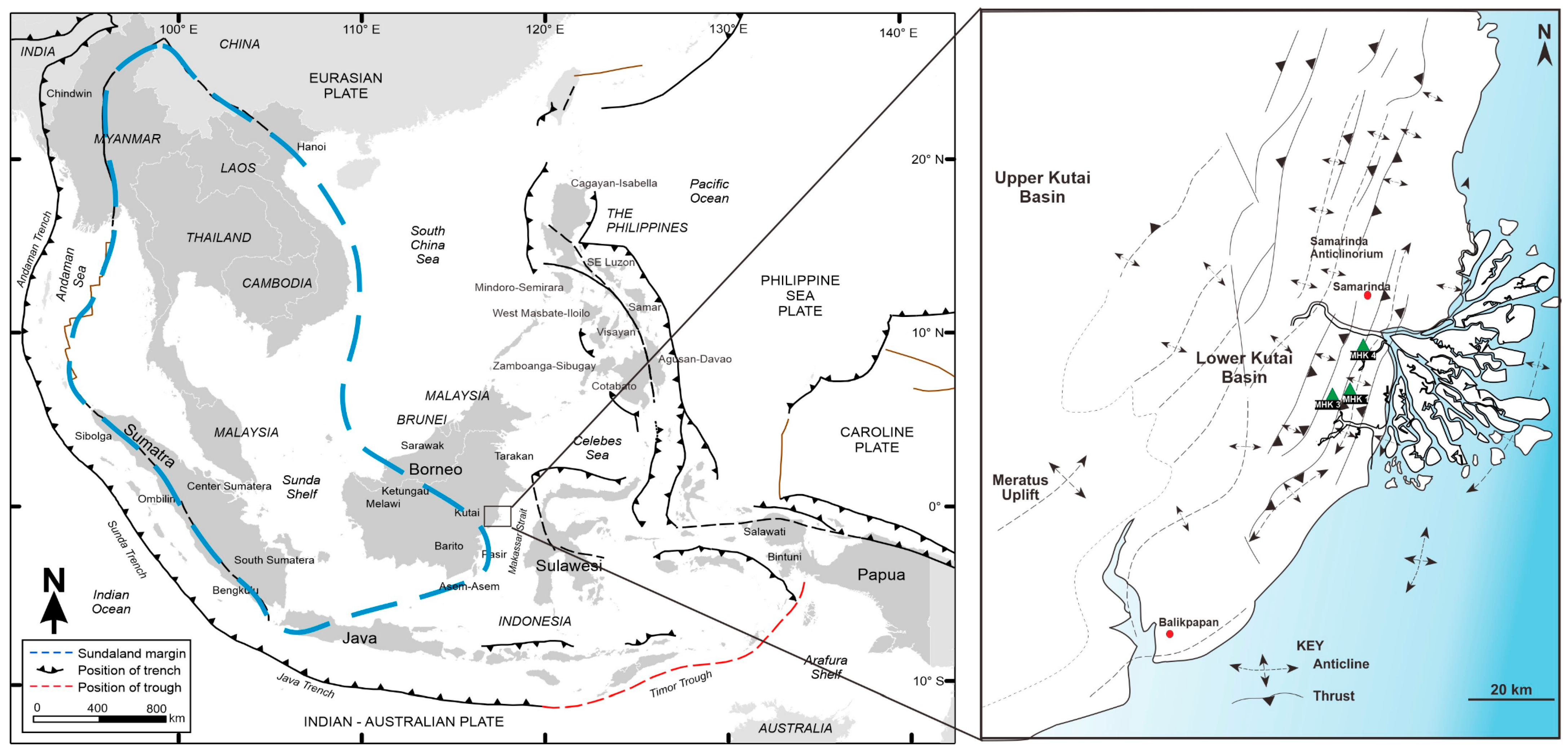
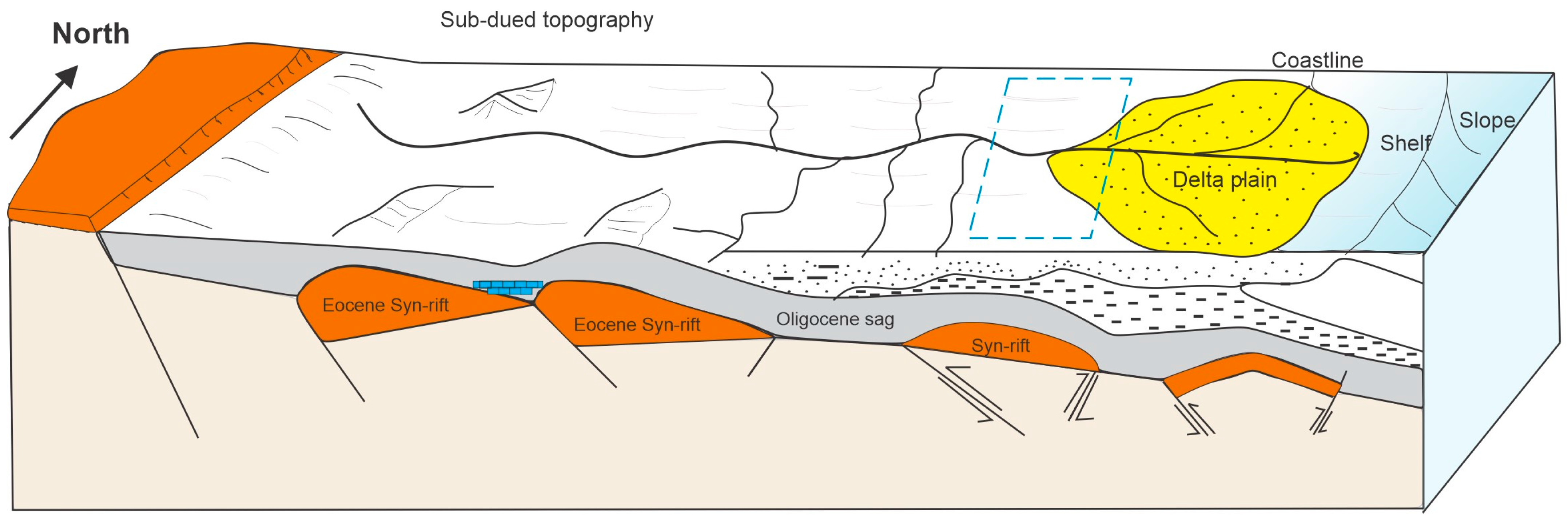



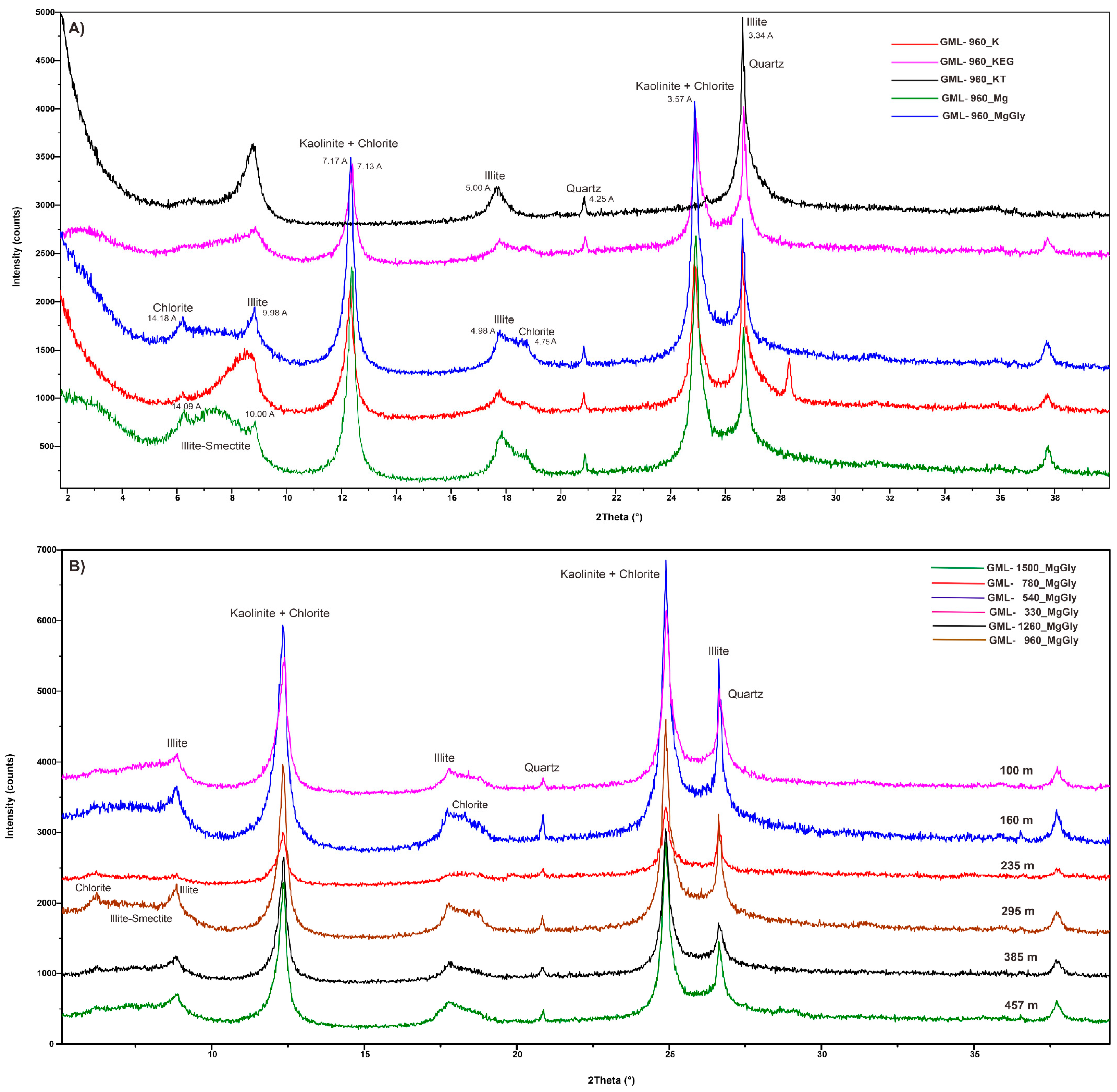
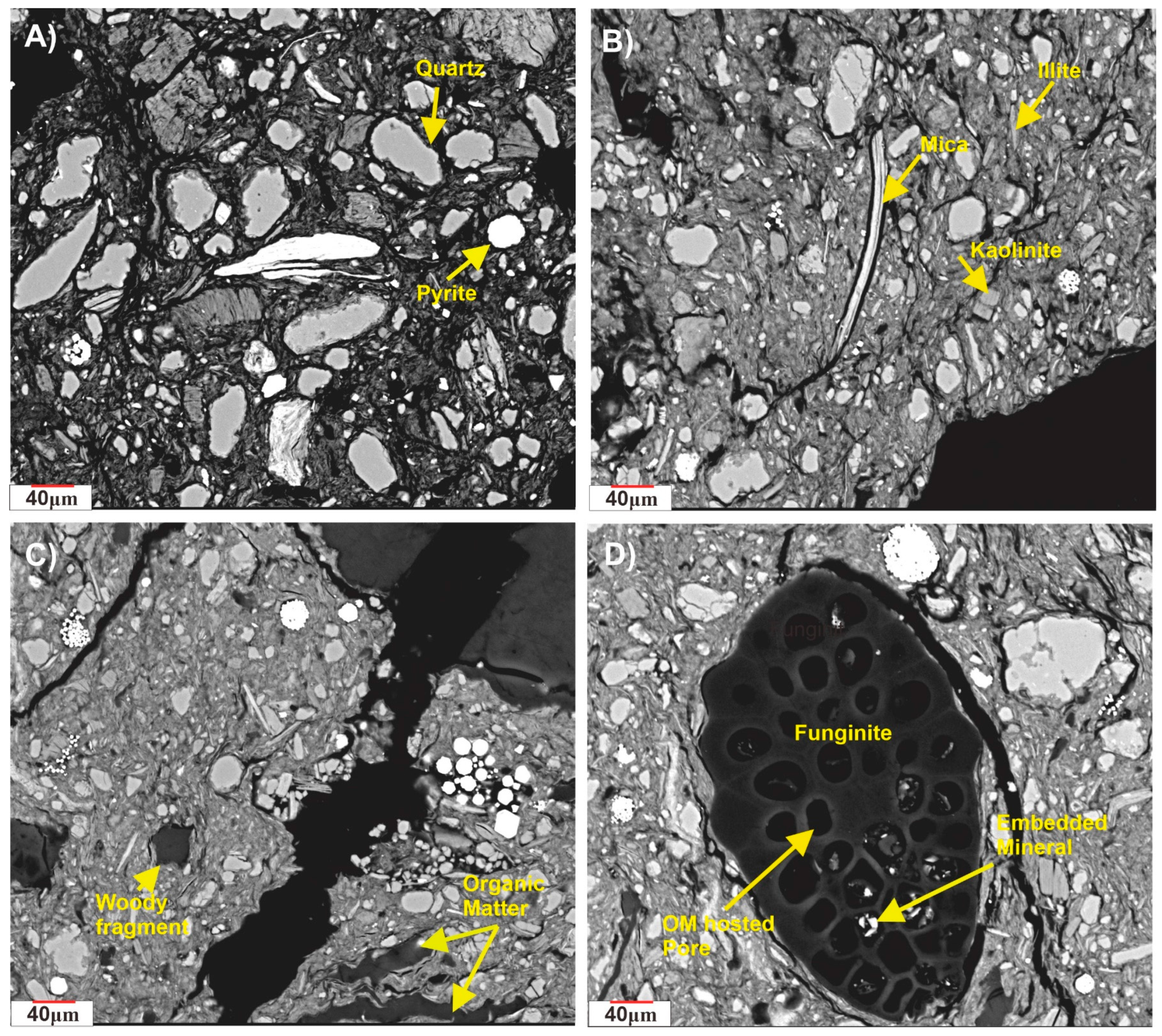
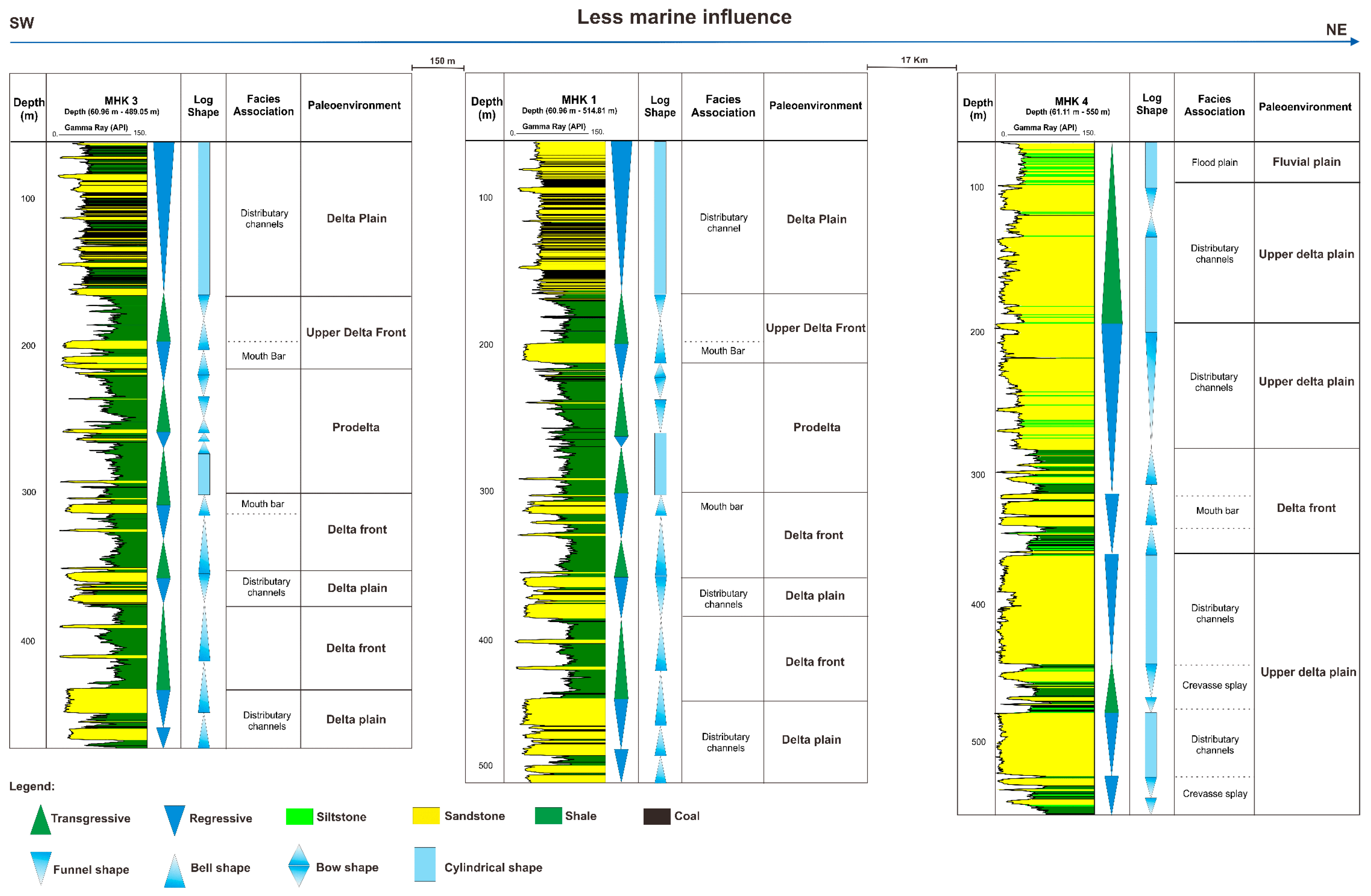


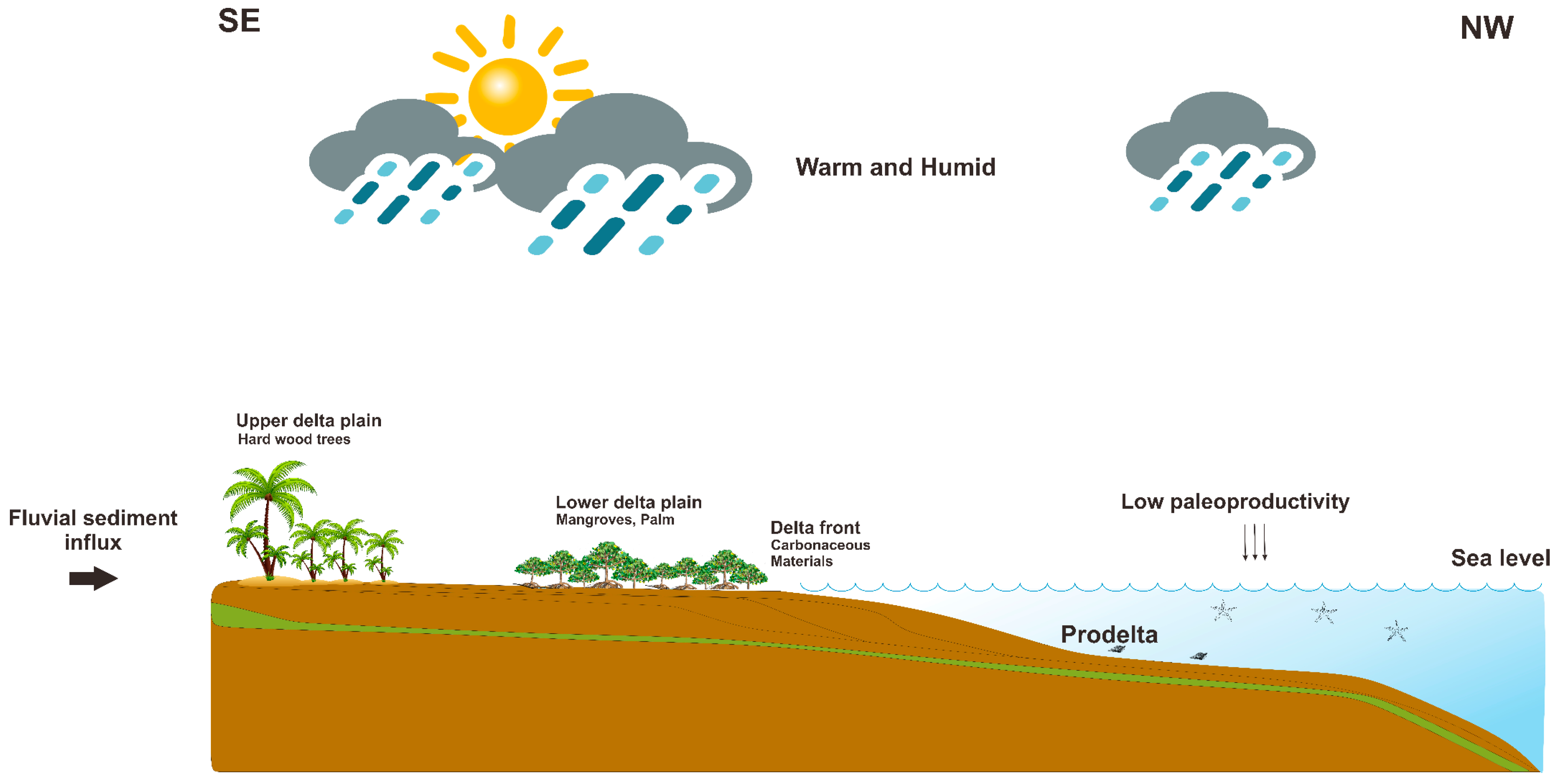

Disclaimer/Publisher’s Note: The statements, opinions and data contained in all publications are solely those of the individual author(s) and contributor(s) and not of MDPI and/or the editor(s). MDPI and/or the editor(s) disclaim responsibility for any injury to people or property resulting from any ideas, methods, instructions or products referred to in the content. |
© 2023 by the authors. Licensee MDPI, Basel, Switzerland. This article is an open access article distributed under the terms and conditions of the Creative Commons Attribution (CC BY) license (https://creativecommons.org/licenses/by/4.0/).
Share and Cite
Jamaluddin; Wagreich, M.; Gier, S.; Schöpfer, K.; Battu, D.P. Sedimentary Environments and Paleoclimate Control of the Middle Miocene Balikpapan Group, Lower Kutai Basin (Indonesia): Implications for Evaluation of the Hydrocarbon Potential. Minerals 2023, 13, 1259. https://doi.org/10.3390/min13101259
Jamaluddin, Wagreich M, Gier S, Schöpfer K, Battu DP. Sedimentary Environments and Paleoclimate Control of the Middle Miocene Balikpapan Group, Lower Kutai Basin (Indonesia): Implications for Evaluation of the Hydrocarbon Potential. Minerals. 2023; 13(10):1259. https://doi.org/10.3390/min13101259
Chicago/Turabian StyleJamaluddin, Michael Wagreich, Susanne Gier, Kateřina Schöpfer, and Desianto Payung Battu. 2023. "Sedimentary Environments and Paleoclimate Control of the Middle Miocene Balikpapan Group, Lower Kutai Basin (Indonesia): Implications for Evaluation of the Hydrocarbon Potential" Minerals 13, no. 10: 1259. https://doi.org/10.3390/min13101259
APA StyleJamaluddin, Wagreich, M., Gier, S., Schöpfer, K., & Battu, D. P. (2023). Sedimentary Environments and Paleoclimate Control of the Middle Miocene Balikpapan Group, Lower Kutai Basin (Indonesia): Implications for Evaluation of the Hydrocarbon Potential. Minerals, 13(10), 1259. https://doi.org/10.3390/min13101259




